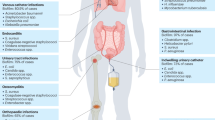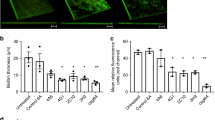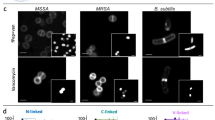Abstract
Antibiotic TA adheres avidly to a variety of surfaces. When administered orally or intravenously to animals, the antibiotic concentrates in an active form close to the site of administration. No measurable blood level of the antibiotic is found. Tissues treated with antibiotic TA and then washed continuously to remove unbound antibiotic retain bactericidal activity. Antibiotic TA may have applications in circumstances where an active bound antibiotic is desired.
This is a preview of subscription content, access via your institution
Access options
Subscribe to this journal
Receive 12 print issues and online access
$209.00 per year
only $17.42 per issue
Buy this article
- Purchase on Springer Link
- Instant access to full article PDF
Prices may be subject to local taxes which are calculated during checkout
Similar content being viewed by others
References
Rosenberg, E., Vaks, B. and Zuckerberg, A. 1973. Bactericidal action of an antibiotic produced by Myxococcus xanthus. Antimicrob. Agents Chemother. 4: 507–513.
Vaks, B., Zuckerberg, A. and Rosenberg, E. 1974. Purification and partial characterization of an antibiotic produced by Myxoroccus xanthus. Can. J. Microbiol. 20: 155–101.
Fytlovitch, S., Nathan, P.D., Zafriri, D. and Rosenberg, E. 1983. Amino acid precursors of Myxocococcus xanthus antibiotic TA. J. Antibiot. 36: 1525–1530.
Zafriri, D., Rosenberg, E. and Mirelman, D. 1981. Mode of action of Myxococcus xanthus antibiotic TA. Antimicrob. Agents Chemother. 19: 349–351.
Rosenberg, E., Fyllovitch, S., Carmeli, S. and Kashman, Y. 1982. Chemical properties of Myxocuccus xanthus antibiotic TA. J. Antibiot. 35: 788–793.
Freedman, L.R. 1967. Experimental pyelonephritis: XIII. On the ability of water diuresis to induce susceptibility to E.coli bacteriuria in normal rat. Yale J. Biol. Med. 39: 255.
Kunin, C.M. 1970. Binding of antibiotics to tissue homogenates. J. Infect. Dis. 121: 55–64.
Kunin, C.M. and Bugg, A. 1971. Binding of polymyxin antibiotics to tissues: the major determinant of distribution and persistence in the body. J. Infect. Dis. 124: 394–400.
Kunin, C.M. 1980. Urinary tract infections. Surgical Clinics of North America 60: 223–231.
Kohsaka, M. and Demain, A.L. 1976. Conversion of penicillin to cephalosporins by cell-free extracts of Cephahsporium acremonium. Biochem. Biophys. Res. Comm. 70: 405–473.
Author information
Authors and Affiliations
Rights and permissions
About this article
Cite this article
Rosenberg, E., Porter, J., Nathan, P. et al. Antibiotic TA: An Adherent Antibiotic. Nat Biotechnol 2, 796–799 (1984). https://doi.org/10.1038/nbt0984-796
Received:
Accepted:
Issue Date:
DOI: https://doi.org/10.1038/nbt0984-796



